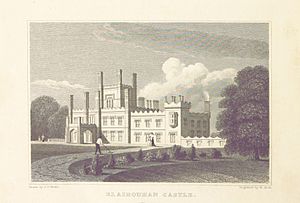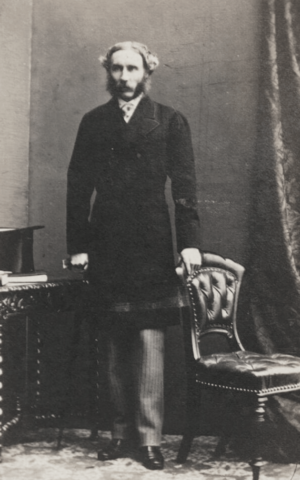Sir David Hunter-Blair, 3rd Baronet facts for kids
Sir David Hunter-Blair, 3rd Baronet (1778–1857) was an important Scottish landowner and businessman. He owned land in Jamaica and also held a special job called the King's Printer in Scotland. This meant his company had the exclusive right to print certain important documents, like Bibles.
Contents
Sir David's Life Story
David Hunter-Blair was the second son of Sir James Hunter-Blair, 1st Baronet. When his older brother, Sir John Hunter-Blair, 2nd Baronet, passed away in 1800, David became the 3rd Baronet.
He started his career in the Royal Navy as a midshipman on a ship called HMS Hyacinth. Later, he joined a famous army group known as the 93rd Highlanders.
David inherited a share of a large estate in Jamaica called Rozelle from his uncle. At that time, many estates in Jamaica used enslaved people for labor. When slavery was ended in the British Empire in the 1830s, Sir David received money as compensation for the enslaved people on his estate.
There's even a traditional dance tune named after him, called Sir David Hunter Blair's Reel. It was first published around 1800.
Blairquhan Castle: Sir David's Home
In 1798, when Sir David was still young, his family bought Blairquhan Castle in Ayrshire, Scotland. They bought it from Sir John Whitefoord, whose family had owned it for a long time.
Sir John Whitefoord was a friend of the famous Scottish poet Robert Burns. Sir David's own father had also been friends with Burns. In 1814, Sir David attended a meeting in Alloway that helped create the Burns memorial near Burns Cottage. This memorial honors the poet.
Sir David made many improvements to the Blairquhan estate. He changed the path of the river and planted many trees between 1803 and 1814. He also hired famous architects to design new plans for the castle.
From 1821 to 1824, Sir David had the castle completely rebuilt by an architect named William Burn. The new design was in a beautiful Tudor Gothic style, making it look like a grand old English manor. The gardens were designed in 1816 by John Tweedie.
King's Printer and Bible Printing
Sir David Hunter-Blair also had a share in a very important and profitable business: being the King's Printer for Scotland. This meant his company had a special permission, called a patent, to be the only one allowed to print Bibles in Scotland. This patent was given for 41 years, starting in 1798.
This job was very valuable because everyone needed Bibles. The patent meant that other printers couldn't print common Bibles, which made them more expensive for people to buy.
How the Monopoly Started
The special right to print Bibles was first given by the government in 1785. It was a political favor from a powerful politician, Henry Dundas, to Sir David's father, James Hunter Blair. Even though James Hunter Blair died in 1787, the right to print Bibles passed down to his family.
The patent was also shared with John Bruce, who was a tutor to Dundas's son. Before Sir David's family, another company, Mark & Charles Kerr, held the monopoly until 1798. Sir David's company printed many Bible editions and even sold them in England.
Challenges to the Monopoly
In the 1820s and 1830s, people started to question this monopoly. Many felt that Bibles should be cheaper and easier for everyone to get.
In 1823, Sir David successfully won a court case to stop Bibles from being brought into Scotland from England. One of the main people who disagreed with him was John Lee. Lee wrote that the cost of defending the Scottish monopoly was being paid by the English Bible printers. He argued that they would benefit most from stopping trade.
John Bruce, Sir David's partner in the printing business, passed away in 1826. His share of the business went to his niece, Margaret Stuart Bruce.
The Monopoly Ends
In the 1830s, the British Parliament started looking into these printing monopolies. A special committee of the British House of Commons investigated the Scottish monopoly starting in 1831. Sir David Hunter-Blair explained how the costs worked for printing Bibles.
Another committee was set up in 1835. Many people spoke out against the monopoly, arguing that it made Bibles too expensive. Adam Thomson of Coldstream led a big campaign to stop the patent from being renewed.
His efforts were successful! The patent was allowed to end in 1839. This meant that from then on, anyone could print Bibles in Scotland, and Bibles could be imported from other places. This made Bibles much more affordable for everyone.
Sir David's Family
Sir David Hunter-Blair was married twice and had many children.
His first marriage was in 1813 to Dorothea Hay-Mackenzie. They had two sons and one daughter:
- James Hunter-Blair, who became a Member of Parliament. He sadly died in 1854 during the Battle of Inkerman.
- Sir Edward Hunter-Blair, 4th Baronet (1818–1896), who took over the baronetcy after his father.
- Maria Dorothea, who married Walter Elliott in 1838.
In 1825, Sir David married his second wife, Elizabeth Hay. They had four sons and two daughters:
- John Hunter-Blair (born 1825), who worked in India.
- David Hunter-Blair (1827–1869), who served in the Scots Guards.
- William Hunter-Blair (1828–1855), who was in the Royal Horse Artillery.
- Henry Arthur Hunter-Blair (born 1833).
- Mary Elizabeth (died 1870), who married Robert Vans-Agnew in 1852.
- Jane Anne Eliza, who married Philip Lutley Sclater in 1862.



